#840 Tom’s Kootenay Lake memories
Tom’s Gray Creek: A Kootenay Lake Memoir. Part I: Early Years to 1945
by Tom Lymbery
Gray Creek: Gray Creek Publishing, 2013
$29.95 / 9780992152109
*
Tom’s Gray Creek: A Kootenay Lake Memoir. Part II: Years of Change, 1946 to 1980
by Tom Lymbery with Frances Roback
Gray Creek: Gray Creek Publishing, 2016
$29.95 / 9780992152116
Both books reviewed by Luanne Armstrong
Tom’s Gray Creek is available from bookstores, museums, and other outlets throughout the Kootenays as well as by mail from the Gray Creek Store website — Ed.
*

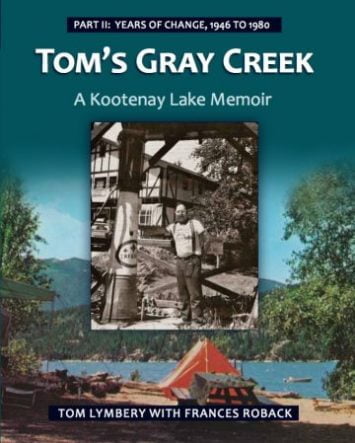
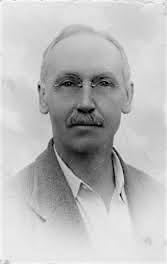
It took me a while to learn to care deeply about local history. I think when you’re young, the world always seems more exciting and interesting somewhere else. And I am not a historian by trade, I am a writer, I write memoir, which is not about truth or memory, it is about making meaning out of stories. I write stories and I help other people write stories and I look constantly for stories of the place and community where I live. Stories are the bedrock of human existence; we make our lives out of the stories we tell each other. History is, for me, much like a Russian doll, a series of small individual decisions, collecting over time into a series of individual stories, that are set within a particular time and place, and then the accumulation of all these many stories on a macro level becomes history.
I have spent much of my life in one place, a piece of land that was my grandfather’s, my parents,’ now mine. I walk every day, looking, listening, seeking understanding of where I live and how to live in peace with all the other beings around me; so now I also research, gather stories of what has happened here throughout history, not just settlers but First Nations, and fish and birds and rocks and trees. History is ever forming just in front of me.

When the Tom’s Gray Creek books came along, I was thrilled. Not only are these books extraordinarily beautiful (thanks to the exemplary and painstaking design work of Warren Clark), they are also eminently readable and well told.
Unfortunately, not all local history books are like this. All too often, they are merely typed, photocopied, and ring bound. They have some limited use for historians but are not always lot of fun to read.
But Tom, wisely, had help, help with the editing and research from a number of people. He also had a ready audience in people who had been reading his column in the East Shore Mainstreet newspaper for many years, and who had gone to the Gray Creek Store for help, advice, necessary tools like chain saws, wood stoves, and who were lucky enough to hear stories from Tom about his long life as a boy and as a wise shrewd storekeeper on Kootenay Lake. The Gray Creek Store was initially built by Tom’s father, Arthur Lymbery, in 1911 and then inherited and maintained and updated by Tom and his family.

The Gray Creek Store is more than a local institution and landmark, it’s still where you go for everything you need for life on the east shore of Kootenay Lake, whether that is new stainless steel pipes for wood stoves and airtight heaters, wool underwear, or a good book.
Kootenay Lake itself has a storied and colourful history. It encompasses a huge territory, long shared over thousands of years by the Yaqan Nukiy people of the Ktunaxa Nation, by the Sinixt, and by the Secwepmic people. When settlers first came, their transportation was by train and sternwheeler, or often, the family rowboat or canoe. For many years. the huge majestic sternwheelers swept along the whole 104 kilometre length of the lake until a railway on the west side, and the highway on the east side, were completed. Because it is in a narrow valley bounded by two mountain ranges, the lake is well known for its sudden storms and fierce winds and one sternwheeler, the City of Ainsworth, in 1898, paid the price for being out in such a storm.

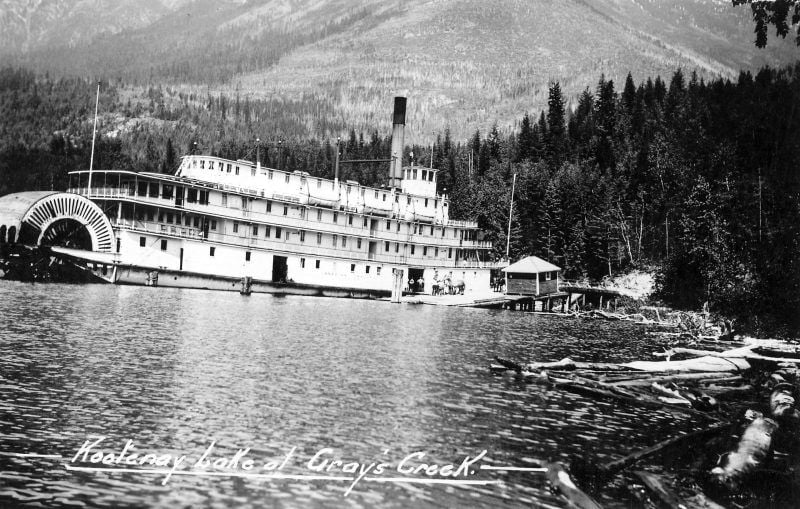
But all through this colourful history, the Gray Creek Store and Tom Lymbery’s family, were serving the people who came to homestead, prospect, work in the mines, build houses, and raise their families. The east shore is not always an easy place to live; houses and homesteads perch on the toes of the rugged Purcell Mountains, creeks flood, roads wash out, fires are started by lightning. You need to always be a bit of a pioneer to live here.
And finally, when Tom had enough time, he began to put together a family memoir which grew and grew and became first one, and then two histories of the area.
The genius of Tom’s vision is that he began with Gray Creek and its pioneer families, stories of which are interwoven together, and then he expanded his vision to many anecdotal stories of railway building, road building, pioneer families, local characters, and pictures; lots and lots of black and white photos, set into the book design so that they define and bracket each story. You can look at this book or read or browse this book or keep it as a reference, or buy it for new people as a gift so they can understand where they have come to live.
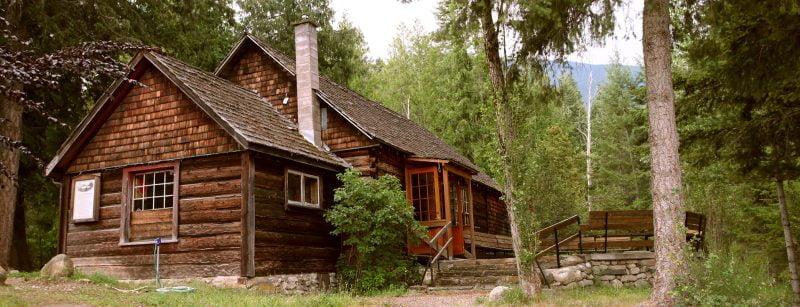

The first book covers the era of 1893 to 1945, and the second book covers the years from 1946 to 1980. The research and writing that has gone into them is phenomenal. In addition, the books include a glossary, a list of references, and are fully indexed. Tom did the index himself, by simply going through the books one word at a time, a tedious but incredibly useful-to-the reader process. Tom and his wonderful wife Sharon have re-settled in Nelson now, but Tom continues to research and write history.
I am very fortunate to have known Tom most of my life; I absolutely love browsing the Gray Creek store and I always find something there that I need but maybe didn’t know I needed. Tom is a bit older than me and so he was also good friends with my mom and dad. Sharon and I and my mother stood side by side for many years singing in the choir for the local St. Anselm’s Church at Boswell. I know them both as friends, and as wonderfully caring, community minded neighbours.
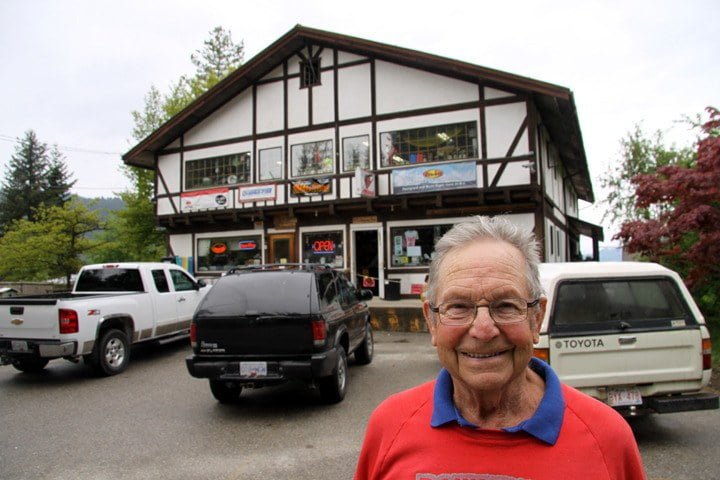
These books set a standard for writing local history. I hope they serve as a template for anyone contemplating writing the history of their own community. Unfortunately, I don’t think they are as well known as they deserve to be outside of the Kootenay-Columbia area. Until you read through them, you don’t realize the level of detail and the many fascinating segues into anecdotes and stories of true pioneer life these books contain. They are not so much about Gray Creek as they are about Canadian pioneer history, about the work and caring and care that went into creating the places we so take for granted now. Each family story is a miniature adventure through the past. They have depth and power and are beautifully written as well.
You can order the books from the Gray Creek Store website (which, in itself, is a fun place to visit), and I highly recommend you get both of them. And then keep them for the grandkids, when they are finally old enough to want to know what happened and how we all got here.

*
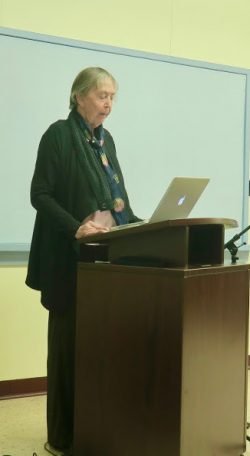
Luanne Armstrong has written twenty-one books. She writes young adult book, fiction, nonfiction and poetry. She has contributed to many anthologies and edited a Canadian non-fiction anthology called Slice Me Some Truth (Wolsak and Wynn, 2011). She has been nominated or won many awards, including the Moonbeam Award the Chocolate Lily Award, the Hubert Evans nonfiction Book award; the Red Cedar Award, Surrey Schools Book of the Year Award, the Sheila Egoff Book Prize, and the Silver Birch Prize. Luanne lives on her hundred year-old family farm on Kootenay Lake. She mentors many emerging writers all over the world on a long term basis, and in the last three years has edited eight books through to publication. Her last book was Sand, a young adult book for Ronsdale Press. A Bright and Steady Flame, The Story of an Enduring Friendship, was published by Caitlin Press in 2018 [and reviewed by Lee Reid in The Ormsby Review no. 418, November 9, 2018 – Ed.]. She is now working on a book of essays, Going to Ground, as well as a new book of poetry, When We Are Broken.
*
The Ormsby Review. More Books. More Reviews. More Often.
Publisher and Editor: Richard Mackie
The Ormsby Review is a journal service for in-depth coverage of B.C. books and authors. The Advisory Board consists of Jean Barman, Robin Fisher, Cole Harris, Wade Davis, Hugh Johnston, Patricia Roy, David Stouck, and Graeme Wynn. Scholarly Patron: SFU Graduate Liberal Studies. Honorary Patron: Yosef Wosk. Provincial Government Patron since September 2018: Creative BC
“Only connect.” – E.M. Forster
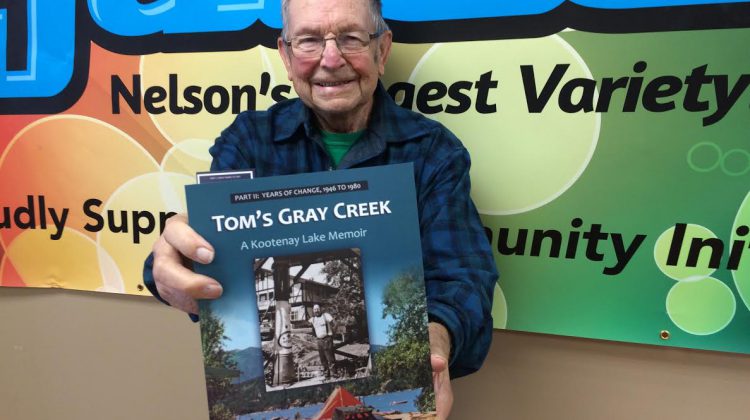
5 comments on “#840 Tom’s Kootenay Lake memories”
Please send me your newsletter.
Hi my name is Robin Baribeau. I was lead carpenter building the new store. My daughter saw a picture of me working on it and asked what year it was, but I don’t remember and none of your articles mention the date. Please leave a comment if you know the date. Thanks! — Robin
I lived in the Little Log Cabin as a youth hosteler in the early 70’s. Loved Kathleen Lymbery!
We camped for many years at Gray Creek: my family, siblings and their families. I loved being there and seeing Tom making his round of the campgrounds numerous times a day. This was how our families spent many summer vacations camping there: fishing, swimming, water skiing, hiking, and campfire sing-a-longs. Many great memories! Thank you, Tom.